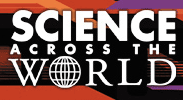Dr Lida Schoen reviews Science Across the World, the largest global schools network for students 10-16.
 |
Global schools network
Science Across the World is the largest global schools network for students 10-16 years of age. One of the great things about it are the ready-made resources on many science topics related to everyday life. Another plus is the database where schools can find their partner schools in other countries (around 6750 available schools in 138 countries as of August 2008). The programme started in 1990 [1].
Ready-made resources
As a science teacher and trainer, there are many materials I can use on topics such as 'Chemistry in our lives', 'Talking about Genetics', 'Keeping Healthy', 'Drinking Water' (related to the UN's Decade on Water for Life 2005-2015), 'Climate Change' and 'Renewable Energy'. All topics include an introduction to the issue, teachers' notes, student work pages, support data and an Exchange Form.
The topics also give scope for exploring science issues that might differ from one region or culture to another, or from one country to another. SAW goes beyond finding facts, it explicitly explores science in its social context. Students collect data, facts and opinions locally/nationally. The topics take four to six hours to complete, possibly including a homework assignment. Students exchange their results globally with students by email, internet, fax or post. SAW offers ongoing support to students and teachers through its website.
Exchange with students from schools in other countries
After registration for a topic, teachers and students can search the schools database for schools to exchange with. The standardised Exchange Forms and complimentary materials can be sent online. After receiving the Exchange Forms from other schools, global findings can be discussed and complemented with additional examples of best practices from the exchange form library. Although many schools still transfer their Exchange Forms by mail or fax, the vast majority now use the website. This creates a real purpose in using the internet to communicate with schools in other countries. It also offers opportunities for developing skills in information and communication technology (ICT). These include research using topic data and hotlinks, creating and using spreadsheets and graphs, setting up exchanges with schools across the world, completing and sending Exchange Forms through the website in many different formats and creating school websites related to the Exchange Form.
New real-time interactive possibilities
The latest topic, 'Climate Change', offers elaborate interactive possibilities for students to share their work. The Open University (United Kingdom)developed software for 'Flashmeeting', a simple yet well-structured way for videoconferencing with up to six participants. The session is recorded for later analysis in the classroom. Students can also upload their results, including audio and video to the Making the News (MTN) site, hosted by the National Education Network (United Kingdom).
Science and languages
The topics complement school curricula and they are written by educators and experts in the issues from a wide range of countries. The programme encourages cross-curricular work (for instance science and English classes together) and promotes independent learning among students of the same age all over the world. The materials are translated into many languages, including, apart from many European Union languages, Russian, Chinese and Arabic, so teachers (and students) can choose which language to work from. Partner schools have to decide in what common language they will exchange their results. The topics are structured flexibly to suit adaptation for a wide range of curricula. SAW is developed and managed from the United Kingdom by the Association for Science Education. Partners include the British Open University and the National Education Network, the British Council and the Comenius (in-service training for teachers) programme of the European Union.
Young Ambassadors for Chemistry
SAW is a major contributor to IUPAC's Young Ambassadors for Chemistry project [2]. In Taiwan a workshop for teachers and students was organised several times (2004 and 2006) in different regions with very positive feedback. From the questionnaire close to 90% of the students expressed that participation in YAC/SAW helped them understand better the relationship between chemistry and daily life and that they would like to join this activity in the future. Similarly, the teachers strongly showed their positive affirmation. One teacher said the he will use "Chemistry in our life" in his extra-curricular activities and ask students to do some hands-on activities. Another teacher mentioned that he will use SAW activities to allow students to explore science from a different perspective.
References
[1] Marianne Cutler, Science Across the World, Exploring Science Locally and Sharing Insights globally, Chemistry International, 28, 4 (2006) 8-11
[2] Young Ambassadors for Chemistry: www.iupac.org/web/ins/2003-055-1-050

No comments yet